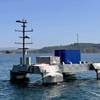Cameron Liquefaction Project Proposed
The staff of the Federal Energy Regulatory Commission (FERC) has prepared a draft environmental impact statement (EIS) for the Cameron Liquefaction Project, proposed by Cameron LNG, LLC and Cameron Interstate Pipeline, LLC (collectively Cameron).
The project is proposed in Cameron, Calcasieu and Beauregard Parishes, Louisiana, and would provide Cameron the capability to export about 12 million tons of liquefied natural gas per year. Cameron would construct three separate systems that liquefy natural gas; one 160,000-cubic-meter, full-containment LNG storage tank; refrigerant make-up and condensate product storage; a truck loading/unloading area; one marine work dock; minor modifications to existing terminal facilities; 21 miles of 42-inch-diameter pipeline; one 56,820-horsepower compressor station; and ancillary facilities.
The EIS was prepared in compliance with the requirements of the National Environmental Policy Act (NEPA), the Council on Environmental Quality regulations for implementing NEPA (40 Code of Federal Regulations [CFR] 1500–1508), and FERC regulations implementing NEPA (18 CFR 380). The U.S. Army Corps of Engineers, U.S. Coast Guard, U.S. Department of Energy, and the U.S. Department of Transportation cooperated in the preparation of the draft EIS.
FERC’s environmental staff concludes that construction and operation of the project would result in some adverse environmental impacts. However, these impacts would be reduced to less-than-significant levels with the implementation of Cameron’s proposed minimization and mitigation measures and the additional measures recommended by the FERC staff in the draft EIS. Although many factors were considered in this determination, the principal reasons are:
- Cameron Interstate would collocate 100 percent of the pipeline with existing rights-of-way.
- The project would be consistent with or in conformance with federal authorizations, including coastal zone, the Clean Water Act, and the Clean Air Act.
- Cameron would implement resource- or activity-specific plans, procedures, and agreements to protect natural resources, avoid or limit environmental impacts, and promote restoration of all disturbed areas during construction and operation of the project.
- The use of the HDD method would avoid disturbances to a number of wetlands and major waterbodies along the route.
- The appropriate consultations with the FWS, COE, SHPOs, and any appropriate compliance actions resulting from these consultations, would be completed before Cameron would begin construction in any given area.
- An environmental inspection program would be implemented to ensure compliance with all mitigation measures, Certificate conditions, and other stipulations included in permits from other authorizing federal, state, and local agencies.
Comments on the draft EIS must be received in Washington, DC on or before March 3, 2014. Once the final EIS is issued, the FERC Commissioners will take into consideration staff’s recommendations when they make a decision on the project.













